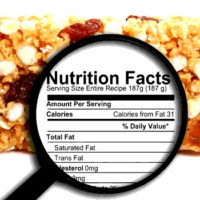Nutrition Labeling: Current Status and Future Challenges
Many countries are adopting simple, front-of-pack labels to communicate nutrition information to consumers

Consumers need a user-friendly tool to make the right decisions regarding the best food choices. The nutritional labeling of packed food is a much-discussed point by all of the actors involved, starting with the food producers and distributors and continuing with the food policy organisms and consumers. The information that should appear on the package differs according to the opinions of the different actors involved, but there are also differences between continents—especially the U.S. and the EU—as well as between EU countries.
The bodies responsible for drawing up the guidelines for the nutrition labeling of packaged foods are the World Health Organization (WHO) at a global level, including the Food and Agriculture Organization (FAO)/WHO Food Standards Program; EU Commission bodies for the EU, and the Food and Drug Administration (FDA) for the U.S.
Nutrition Labeling History
The first rules for introducing nutrition information on packaged food labels were formulated in both the U.S. and the EU in the early 1990s. The Codex Alimentarius nutrition labeling guidelines were revised in 1993 and again in 2011. The EU adopted Regulation 1169 in 2011 to modify the region's existing food labeling framework and to deliver updated food information to consumers. As result, new EU nutrition labeling rules went into effect in 2016. FDA revised its regulations in 2016, and U.S. nutrition labels were required to be updated from January 2020.1
The latest revisions incorporate recent knowledge regarding nutrient requirements and the relationships between diet, chronic disease, and public health. A comparison of some of the features of mandatory nutrition information on packaged foods in the U.S. and EU and in the Codex guidelines is presented in Figure 1.
FIGURE 1. Comparison of Mandatory Nutrition Information on Packaged Foods in U.S., EU, and per Codex Guidelines

The best way to communicate this complex information to consumers, in a form that is easy to read and understand, is still under development in many countries. Consumers are increasingly interested in nutritional product information. For this reason, many countries are adopting front-of-pack (FOP) labels, with several designs already available for different markets.
The purpose of FOP labels is to transmit to consumers the most important nutrition information, in a simplified way, to help consumers make healthier choices. In the literature, FOP labels are divided into two categories:
- Those containing nutrient-specific indicators that provide detailed information (e.g., Dietary Reference Intakes label, NutrInform Battery, Multiple Traffic Light labels, Warning Symbols)
- Summary indicators with an overall score of the nutritional quality of the product (e.g., Tick, Green Keyhole, Healthy Choices, Health Star Rating, SENS, NuVal, Nutri-Score).2
The first FOP logo was developed by the Swedish National Food Agency and was presented as the Keyhole logo. Green marks the healthier choice of 33 food groups (e.g., bread, cheese, and ready meals) based on the level of the nutritional compounds (e.g., fat, sugars, salt, wholegrain, fiber).3 Recently, the most discussed FOP labels are the Traffic Light scheme (Figure 2), the Nutri-Score label, and the NutrInform Battery.
FIGURE 2. Traffic Light Nutrition Label

Moreover, the Traffic Light labeling scheme offers useful information about the percentages of guideline daily amounts for each ingredient. Consumers can decide to buy packaged foods after considering the products' health ratings, as determined by the "lights" on the label, along with the guideline daily amounts of the different ingredients.
Nutri-Score Label (NS)
The Nutri-Score label (NS) (Figure 3) is a color-coded, graded FOP label that shows a scale of five colors from dark green to red. The NS algorithm combines positive characteristics (e.g., fruit, vegetables and nuts, fiber, protein, and rapeseed, walnut, and olive oils content) with negative characteristics (e.g., energy, total sugar, saturated fatty acids, and sodium content) to achieve a score of –15 (most healthy) and +40 (least healthy).
FIGURE 3. Nutri-Score Nutrition Label

This score is reduced to a combination of a letter (A to E) and a color (from dark green to red), where A reflects the highest nutritional quality and E indicates the lowest (Figure 4).
FIGURE 4. The NS for Different Food Products on the Romanian Market

NutrInform Battery scheme
The NutrInform Battery scheme (Figure 5) was developed in Italy in 2020; however, it has not yet been implemented due to ongoing discussion regarding the clarity of the message. The proposed labeling scheme is controversial not only between countries (Italy and France), but also between internal stakeholders. Contradictory opinions have emerged regarding the objectivity of the calculation algorithm, which is based on the Reference Intakes label, with the battery symbol indicating the amounts of energy and nutrients in a single serving as a percentage of the daily recommended intake.
FIGURE 5. The NutrInform Battery Labeling Scheme

The NutrInform Battery labeling system is not approved by associations that consider it difficult to understand or misleading, but it is supported by Italian producers that consider the unique battery label as a means of protecting and promoting Italian food and beverage production.3,4
FOP labels are not a substitute for the detailed nutrition label that remains mandatory in the EU, but they provide a simplified way for consumers to understand complex nutritional information and to help them make simple, healthy decisions.
In addition to these different public FOP schemes, some private schemes are present on the EU market, such as the Reference Intakes Label and the Healthy Choice logo. At the EU level, there are several proposals for nutrition label designs based on different algorithms of classification; these differences are the subject of controversy on the subject among different countries.5
According to the EU's Food Information to Consumers regulation, several FOP schemes have been developed and/or endorsed for the EU market: the Keyhole logo (used in Sweden from 1989, Denmark from 2009, Lithuania from 2013, and adopted by non-EU countries like Norway and Iceland), Nutri-Score (used in France from 2017, Spain from 2018, Belgium from 2019, The Netherlands from 2019, Germany from 2020, Luxembourg from 2020, and Romania from 2021), the Heart Symbol (used in Finland since 2000 for nine main food categories), the Little Heart logo (used in Slovenia since 1992), the Healthy Living logo (used in Croatia since 2015), and the Traffic Light scheme (also used in Ireland).3,6
Several studies have focused on the evaluation of the impact of different FOP schemes on consumer selection. The goal of one study was to compare four FOP schemes: the Traffic Light label, Guideline Daily Amounts (% GDA), Nutri-Score (NS), and Health Star Rating. The results show that all FOP labels analyzed lead to a better choice than the lack of a nutrition label (control condition), although a comparison among the different FOP labeling schemes showed no significant differences in consumer choice.7
FOP Labels Find Favor
Different FOP nutrition labeling schemes have been developed by public institutions, non-governmental health organizations, and also by the private sector. Most existing schemes are evaluative schemes (interpretive) that are based on models for profiling their nutritional indicators or synthetic indicators as energy value.
Despite the differing views of EU countries on the use of different types of FOP nutritional labels, in the current context of globalization, it would be helpful for consumers to have a harmonized, common approach. The preliminary results of some studies show that the use of any type of FOP nutrition labeling helps consumers make simpler, more health-conscious food choices compared to the lack of a FOP label.
References
- Campbell, E.J., J.E. Hoadley, and R.C. Post. "Chapter 16: Nutrition in Labeling." Present Knowledge in Nutrition. Amsterdam: Elsevier, 2020.
- De Temmerman, J., E. Heeremans, H. Slabbinck, and I. Vermeir. "The impact of the Nutri-Score nutrition label on perceived healthiness and purchase intentions." Appetite 157 (February 2021). https://doi.org/10.1016/j.appet.2020.104995.
- European Commission. "Report from the Commission to the European Parliament and the Council regarding the use of additional forms of expression and presentation of the nutrition declaration." SANTE/127/2015-EN, Rev. 4. Brussels, May 20, 2020.
- "Varese: No to "Nutri-Score," yes to the "battery" label that protects the quality of our products." Luinotizie. August 16, 2020. https://www.luinonotizie.it/2020/08/16/varese-no-al-nutriscore-si-alletichetta-a-batteria-che-protegge-la-qualita-dei-nostri-prodotti/295951.
- European Commission. "Nutrition labelling." https://ec.europa.eu/food/safety/labelling-and-nutrition/food-information-consumers-legislation/nutrition-labelling_en.
- European Union. Eur-Lex. "Document 02011R1169-20180101." January 1, 2018. https://eur-lex.europa.eu/legal-content/EN/TXT/?uri=CELEX:02011R1169-20180101.
- Santos, O., V. Alarcão, R. Feteira-Santos, J. Fernandes, A. Virgolino, C. Sena, C.P. Vieira, M.J. Gregório, P. Nogueira, P. Graça, and A. Costa. "Impact of different front-of-pack nutrition labels on online food choices." Appetite 154 (November 2020). https://doi.org/10.1016/j.appet.2020.104795.
Amalia Carmen Miteluț is an Associate Professor in the Industrial Biotechnology Department, Faculty of Biotechnologies, at the University of Agronomic Sciences and Veterinary Medicine of Bucharest in Romania. She is a graduate of the University of the Lower Danube in Galați, Romania, and holds a Ph.D. in industrial engineering. Dr. Miteluț has rich experience in the fields of food science and technology and food biotechnology.
Looking for a reprint of this article?
From high-res PDFs to custom plaques, order your copy today!




